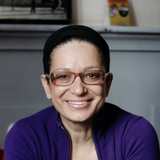Reviving erased stories and histories of 6000-year-old Mediterranean port cities. The Nakba and the ethnic cleansing in 1948 dispersed Palestinians, including Jaffans, as refugees to various corners of the earth. Jaffa, a Mediterranean port city was the most urban, affluent, cosmopolitan, and intellectual Palestinian city. In 1948, from about 120,000 inhabitants only 3700 were left in the city. Jaffan refugees today make about 750,000. Some of them can only see their homes offered for tourists on Airbnb. What was Jaffa like? Who defended it and how? An interactive map leads us to an underground armed resistance group of 14 Jaffan women. The map offers twenty-four stories including photo albums of Jaffa, before it was erased, and makes space for participants to add stories, photographs, and memories. During this evening, we will delve into these stories.





About the programme
Many Jaffans fled to the other Mediterranean port city nearby, Gaza. When Gazans today is sieged, starved, and bombed, we are following the second wave of erasure of many Jaffans, and this time with their neighbors, the ancient Gazans. We delve to revive maps, lives, and stories in Gaza, a city turned into archeology as we watch. Some communities need space and tools to reclaim their histories. The HeritageLab offers a digital platform for deleted or forgotten stories. This interactive platform turns individual memories into collective histories. Stories and heritage have the power to change the way we think and see, not only the past but also the future.
About The Heritage Lab
About the speakers
Sarah al Yahya is a researcher and interactive media artist based between New York and Amman. She’s currently pursuing an MA in Human Rights and the Arts at Bard College. She experiments with multiple mediums including software art, AR, writing, UX/UI design, and physical computing. Her research interests center on digital and internet cultures in Palestine and the SWANA region, and the decolonial and other sociopolitical potential of new media technologies.
Alia Yunis has worked as a journalist, author, and filmmaker on six continents, focusing on memory and heritage –and some science-fiction– particularly in the Muslim and Arab worlds and their diaspora. Her fiction and non-fiction writings and film works have been translated into 10 languages. She is also a professor of film and heritage studies, most recently at NYU Abu Dhabi.

The urban planning evolution of Jaffa has been significantly shaped by political dynamics and conflict. Before 1948, Jaffa exhibited a diverse population and a distinctive urban layout reflective of its unique character. The British and Arab vision of the time aimed to expand and modernize Jaffa's urban fabric; however, the establishment of the State of Israel in 1948 led to a reevaluation of urban plans to accommodate a growing Jewish population and their vision for a modern city. Focusing on specific neighbourhoods, this article delves into the intricate interplay of social, political, and economic forces that have shaped Jaffa’s urban structure, planning strategies, and development outcomes. Through this examination, valuable insights emerge, shedding light on the role of planning in shaping the social fabric of cities navigating significant historical and geopolitical transitions. The article emphasizes the delicate balance between modernization imperatives and the preservation of cultural heritage, underscoring the significance of fostering social inclusion and pursuing equitable development.

While the strip’s future has never seemed more uncertain or its present more crushed, it is imperative to imagine and prepare for a better place.

There are too many unknowns about what happens to Gaza after the war ends. Instead, we should be focusing on the Day Before, and the ways to pave the road for a political settlement for the Palestinians, which includes rebuilding a Gazan economy that does not depend on Israel. Today’s episode of Podcast Palestine: The War on Gaza is with Raja Khalidi, economist and director general of the Palestine Economic Policy Research Institute.

Jaffans in exile are still Jaffans. The 97% of Jaffans who were exiled and their children are forbidden to return. Some are stubborn and imaginative enough to return illegally after death. Others are still resisting, in refugee camps, in Gaza, and in the world, and have a legal and official right to return.
This map is dedicated to the Jaffans.
The intangible history, heritage, and memories can change into tangible.

Palestinian cities were specifically targeted in 1948, Jaffa the most urban and richest Palestinian city, was a main target and was among the ones that struggled the most. Erasing urban Palestinian life was an aim. Cities are where the intellect, business, and culture meet and where the future is built. Jaffa’s highly modernized urban growth resulted in a quadrable population from the 1920s to the late 1940s. Many people arrived in the city from all over Palestine, and the Mediterranean. This meant that a certain cohesion needed in times of war was weak. The defense of Palestine and Jaffa was in the hands of the British Mandate. The British did not defend Jaffa or the Jaffans. Jaffans fought Zionist gangs for their lives, homes, and their city, until the very end. Jaffa fell when Palestine was still Palestine, two days before the state of Israel was declared. The British were part of getting the Jaffans into the sea on boats on the way to exile. The refugees turned Jaffans, 98% of the population, left in all directions, many on fishing boats to the other Mediterranean port city, Gaza. Gaza today has a serious Jaffan part, heritage, and continuity. When we speak about Gazans today, we are often speaking about Jaffans, their children and grandchildren.








